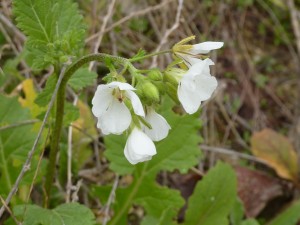I just posted a video of ‘Crocodile Rock’ on www.Twiku.com, so I should be using ‘Rocket Man’ as the theme song for our home, Villa Roquette.
This has encouraged me to look up Roquette, known by other names such as Arragula, Aragula, Rocket, Rocula, Tira, Ruchetta, White Pepper or Eruca Sativa.
It grows wild everywhere around us here in Languedoc and is one of the most common plants we see in walks through the vineyards with our dogs.
It has interesting qualities. Ancient Romans and Egyptians considered it to be an aphrodisiac. The British cultivated it for centuries, and it was in the earliest gardens in New England. Because of the ‘stimulating’ effects, it is still on the official banned list of the Catholic church, I understand.
A good source of iron, calcium and vitamins A and C, Roquette has only been cultivated since about 1990 and is essentially a wild plant.
Eruca sativa is a member of the Brassicaceae (mustard) family.
The edible leaves are characterized by a distinctive spicy, pungent flavor similar to mustard greens. It is a low growing, 8 to 24 inches, herbaceous annual with green, deeply cut, compound leaves. Plants grow densely and develop white or yellowish blossoms with deep violet or reddish veins. Native to the Mediterranean region, it grows wild throughout southern Europe.

Roquette in the vineyards
The entire plant may be harvested, or individual leaves may be cut from the plant. Leaves give a sharp, spicy, pungent, peppery taste similar to horseradish in mixed salads, complementing both bland butterhead lettuce and bitter chicories. Best used raw in salads and in tomato dishes when the serrated leaves are only two to three inches long. It can be steamed, cooked as a potherb, or pureed and added to soups. Harvested leaves can be frozen for later use, similar to spinach or other greens.
In India, roquette is grown primarily for its oil, which is obtained from the seeds.
On the Italian island of Ischia, an alcoholic beverage called Rucolino is made from Roquette. Rucolino is usually consumed as an an after dinner drink. I found this recipe for making it….
Grain Alcohol at 95-96% gr. 500
Distilled Water 500 ml
Pure Cane Sugar gr. 500
Zest of 2 Lemons, diced (Yellow part only)
4 Cloves, whole
Good handful of Roquette, Washed and patted dry
Combine all ingredients in a 2-litre, airtight jar. Shake well until the sugar is dissolved. Macerate the mixture for 2 months in a cool place, away from the sun. Be sure to shake the container now and then. After 2 months, filter the mixture into a new sterilized 2-liter airtight jar. Allow the mixture to rest undisturbed for 6 months then rack. There will be some sediment. Bottle in ice wine bottles to show off the green color. Consume all within 2 years. (No chance of lasting that long 🙂 )
All I have to do now is to ‘test’ the qualities of this clever herb, anyone wishing to assist me in these experiments please contact me